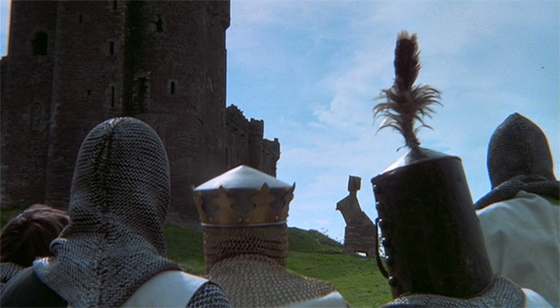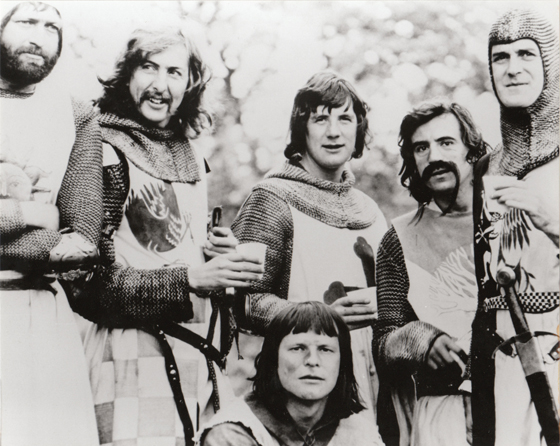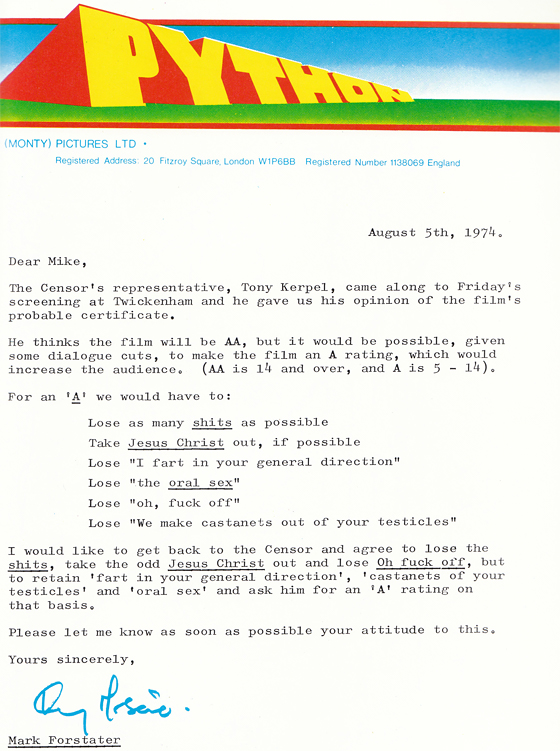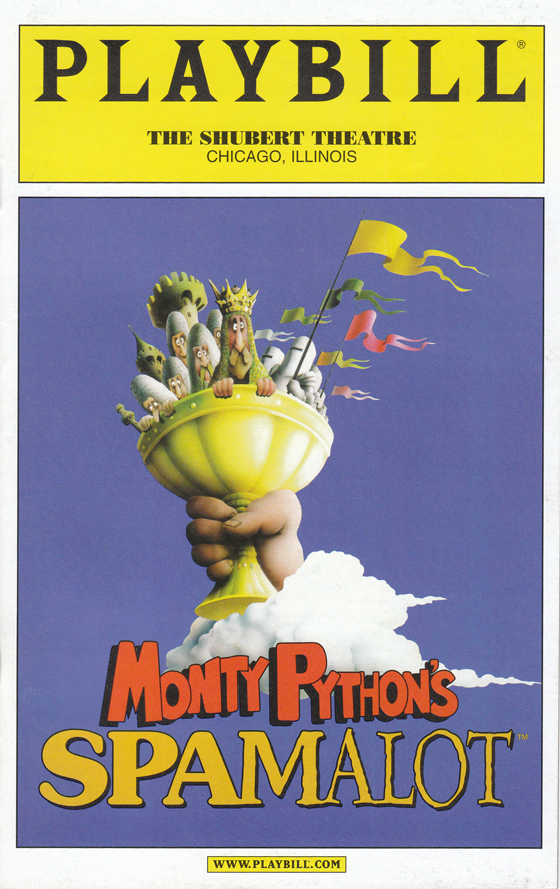
Here in Madison we have a restaurant called the Tipsy Cow, and on the wall hangs a chalkboard that diagrams a key moment from Monty Python and the Holy Grail (1975): a cow being catapulted onto the heads of King Arthur and his knights (or “k…niggets”). Once this was a cult movie; I’m not sure what it is anymore. A few years back Eric Idle launched his “Greedy Bastard Tour,” performing some stand-up, singing songs, and recreating Python sketches before an appreciative audience (including one in Madison). During the tour he began to plan a Broadway version of Holy Grail, working closely with his longtime musical collaborator, composer John Du Prez, who had joined him on the road. Idle received the blessing of the other Pythons, and the resulting musical, Spamalot – starring Tim Curry in the Graham Chapman role, with Hank Azaria and David Hyde Pierce – won the Tony Award. I attended a preview performance while it was still in Chicago’s Shubert Theatre, being edited and rewritten each night. It was a fun experience, but also a disorienting one. It used to be that Monty Python was a members-only club; you had to be initiated by a friend, who would say, “You haven’t seen this? You have to watch this.” The tape which was usually popped into the VCR – the dose of Python guaranteed to cause addiction – was Holy Grail. Of course everyone had heard of Monty Python, but there was still something secret and special and somewhat outlaw about that club – at least in America. Anointed by Tony amidst the glamor of Broadway, Monty Python could no longer pretend to be secret, and was just a little less outlaw. So it’s a relief to revisit this much-memorized, much-recited film and see that it’s still as winningly silly as ever, and fucking hilarious.

"Holy Grail" publicity still: Graham Chapman, Eric Idle, Michael Palin, Terry Jones, John Cleese, and Terry Gilliam (at bottom).
The occasion for revisiting Holy Grail is the new Blu-Ray, which makes this overcast and muddy little Medieval comedy look a lot better than I thought possible. Then again, I realized while watching it that I’m still so overfamiliar with pan-and-scan copies of the film that I can still be surprised to see the entire title card of “The Tale of Sir Launcelot” appearing on the screen without clipping. So it’s hard for me to see this particular movie with new eyes, but the Blu-Ray helps (the animations by Terry Gilliam, so much more colorful than anything else in Holy Grail, pop especially brightly). There is no point in summarizing the film; you have seen it. But I will anyway: this, the Pythons’ second film after the ironically-titled And Now For Something Completely Different (1971) – a big-screen version of their Flying Circus sketches, and a film for which the Pythons had little creative control – is their first with a connecting narrative and all-original material, parodying the legend of King Arthur, the Knights of the Round Table, and the quest for the holy grail. Classic Python moments commence immediately. Arthur (Chapman) rides over a hill with his servant Patsy (Terry Gilliam), who’s clapping two coconuts together because the film’s budget couldn’t afford horses. They greet two guards standing atop an immense curtain wall, but the conversation can’t move past the mystery of how Patsy could have found coconuts in England, so Arthur departs in frustration. Then: the “Bring Out Your Dead” sketch. The “Constitutional Peasants” sketch. The “Black Knight” sketch. The “Witch Burning” sketch (with Fawlty Towers co-writer Connie Booth). The French Taunters, Brave Sir Robin, Castle Anthrax, Swamp Castle, The Killer Rabbit, and on and on. Eventually the film does run out of steam (I submit: everything after the “Intermission” gag; or roughly the last ten minutes), but I was struck on this viewing by just how high the hit-to-miss ratio is. Most comedies these days are lucky to get one memorably funny scene out of 90 minutes, but Holy Grail is chock full of them.

Negotiating with the censors: this memo was reproduced in the "Monty Python and the Holy Grail" tie-in book.
Which is something of a miracle if you consider that, by all accounts, it was an agony to make. It took a long while to arrive at a shooting script, since the original intention was to have some of the action take place in contemporary England (Arthur and his knights take their quest for the grail to Harrods); abandoned material actually worked its way into the fourth, Cleese-free series of the Python show (now called, simply, Monty Python). The location shooting was cold and rain-drenched, which made the woolen “chain mail” unbearable for the actors. Chapman, still struggling with alcoholism, suffered the shakes while trying to cross the genuinely risky Bridge of Death; Cleese had a similar moment of panic while standing atop a narrow crag for his role as Tim the Enchanter – explosions igniting around him. The normally sunny Michael Palin was undone by a scene in which he lurked in the background eating mud for take after take; what he’s doing is barely visible in the shot, somewhat ruining the gag. The decision to have Terry Gilliam and Terry Jones co-direct caused unending tension when the two failed to agree from one scene to the next. (Gilliam surrendered directing duties on subsequent Python films Life of Brian and The Meaning of Life to Jones, who had a smoother rapport with the actors.) Nevertheless, Holy Grail as a cinematic comedy is equally served by Jones’ comic timing and Gilliam’s knack for stunning visuals. The squalor of the sets may have been hell for the actors, but it sharpens the comic contrast between the Pasolini-esque realism and ugliness of Medieval peasant life with the stream-of-consciousness silliness of the script. This is perhaps best illustrated when Palin ridicules King Arthur’s Lady of the Lake origins with increasingly verbose insults – “You can’t expect to wield supreme executive power just because some watery tart threw a sword at you!” – while pointlessly piling mud into a small hillock with his wife (Jones, in “Pepperpot” mode).

Playbill from the preview performances in Chicago for "Spamalot" (prior to its Broadway opening).
The Pythons treated their fans well, giving much thought to every piece of merchandising. The comedy album version – essential in the pre-VHS/Beta era – contained dialogue from the film, but also “huge tracts” of original material from the comedy team. The published screenplay featured early drafts of the script as well as storyboards, Gilliam sketches, and reproductions of the film’s lobby cards, with whimsical descriptions of the plot: “Doug and Bob are metropolitan policemen with a difference…” A CD-ROM computer game in the 90’s (from the defunct 7th Level) was a point-and-click adventure in which the player could visit the film’s various setpieces, clicking through dialogue and collecting items, occasionally rewarded with outtakes or deleted scenes. (The new Blu-Ray finally includes the footage from those snipped scenes, along with animations by Gilliam cut from the film.) Recently there’s even been a Monty Python and the Holy Grail Ale. I believe it’s true that in America, Holy Grail is the most popular Python film, whereas in England, fans hold Life of Brian dearer. It makes sense that Idle would choose Holy Grail as the subject of his Broadway venture – that’s the one Americans know the best. (Life of Brian‘s “think for yourself” message never went over terribly well in this God-fearing country, but I do feel it’s the better of the two pictures.) Decades on from its original release, Holy Grail may be completely appropriated into the culture, but look – Young Frankenstein‘s on Broadway too, and the Glee kids have done Rocky Horror. You can still watch the Blu-Ray and revisit the movie as it ever was. The definitive new disc is spiffed-up, but Palin’s still there on his knees, scarfing mud.

The Tipsy Cow in Madison, Wisconsin









